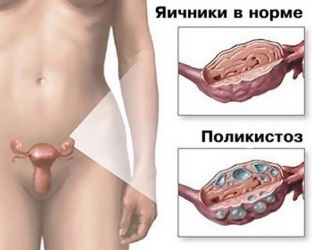Polycystic ovary syndrome is one of the most common gynecological pathologies diagnosed in women of reproductive age. The main symptom of polycystic ovary syndrome is menstrual irregularities. And since the disease in most cases develops at an early age, when the girl’s cycle has not yet been established, such manifestations may not be given much importance. But an untimely diagnosed pathology threatens the girl with the development of infertility in the future. Read about the relationship between obesity and the development of polycystic ovary syndrome at estet-portal.com.
What is the link between PCOS and obesity
To date, there is no consensus regarding the etiological factors of polycystic ovary syndrome. There is still active research in this area and scientists are trying to determine why pathology actually develops. Polycystic ovary syndrome is accompanied by an increase in the production of male sex hormones, which, in turn, provokes masculinization - the appearance of masculine features in women. A fairly large percentage of women with polycystic ovary syndrome are also obese. Thanks to informative studies, scientists were able to find out that the connection between polycystic ovaries and overweight really exists. What is it - read on.
Polycystic ovary syndrome:
- what type of obesity accompanies polycystic ovary syndrome;
- relationship between obesity and polycystic ovary syndrome;
- Peculiarities of treatment of polycystic ovary syndrome in obesity.
What type of obesity accompanies polycystic ovary syndrome
Nearly half of women diagnosed with polycystic ovary syndrome are now obese. In such patients, the visceral type of subcutaneous fat deposits predominates, which is characterized by an increase in the ratio of waist to hip volume, that is, fat deposits are observed mainly in the abdomen. In most of these patients, the moment when the disease first made itself felt refers to the prepubertal and pubertal period. At the same time, the appearance of overweight in these age periods is an independent risk factor for the development of polycystic ovary syndrome. Patients with a body mass index of more than 30 kg/m² are significantly more likely to experience menstrual irregularities, infertility, hirsutism, and increased testosterone levels in the body.

Relationship between obesity and polycystic ovary syndrome
The relationship between obesity and the development of polycystic ovary syndrome is detected both clinically and laboratory. Since hyperandrogenism occurs in the body of patients with polycystic disease, we observe hirsutism and other signs of masculinization clinically, and in the laboratory we see an increase in testosterone levels. In obesity, insulin resistance and hyperinsulinemia are important factors influencing the development of hyperandrogenism. Hypersecretion of insulin, which is often combined with obesity, stimulates the production of androgens by ovarian cells, which lead to atresia of the ovarian follicles. And since insulin suppresses apoptosis, the atrezated follicles do not die, but function for a long time. Excess insulin stimulates the release of luteinizing hormone and increases androgen activity by reducing PSSH synthesis. All this,
Peculiarities of treatment of polycystic ovary syndrome in obesityThe treatment of polycystic ovary syndrome in obese patients has its own characteristics:
- first of all, it is necessary to reduce the patient's body weight to values less than 30 kg/m²;
- patients are prescribed metformin, which reduces the severity of hyperandrogenism and increases the production of PSSH. In addition, this drug is able to restore a regular menstrual cycle, fertility and ovulation;
- hirsutism in obese patients is treated with androgen receptor inhibitors or inhibitors of the conversion of testosterone to dihydrotestosterone;
- Induction of ovulation in such patients is only possible after weight loss.






Add a comment